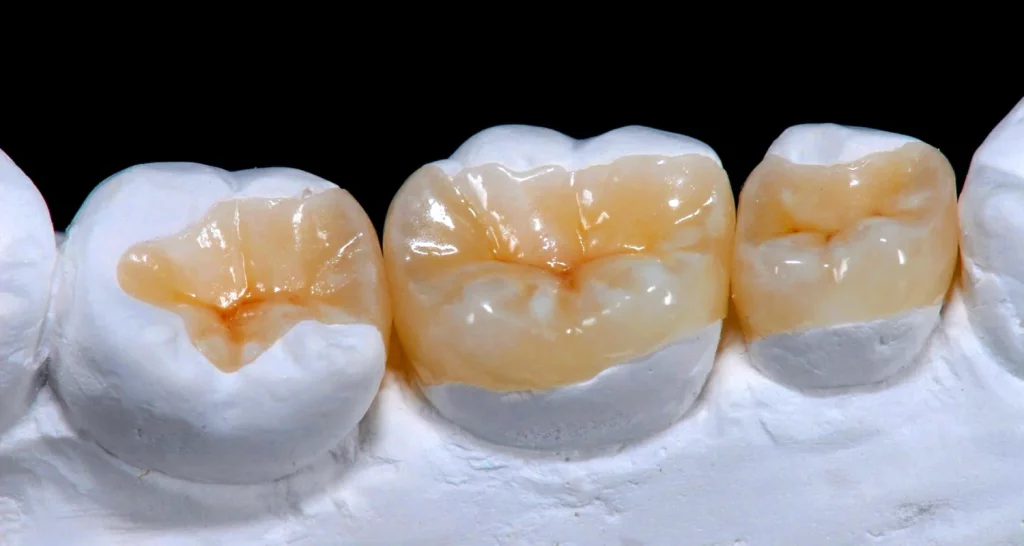Last Updated on: 5th December 2024, 07:41 am
One of the main reasons why someone goes to the dentist is for dental treatments, which includes dental inlay, onlay, and more. The purpose of these treatments is to restore the functionality and structure of an affected tooth. Advances in dentistry, especially dental restoration, have evolved over the years, making these procedures less invasive and much more aesthetic, while maintaining the greater integrity of the tooth.
What is a dental inlay?
Among the many types of dental restorations, some are conservative in nature since they maintain the integrity of the tooth as much as possible. Within this group are “inlays” or. They are indirect restorations (i.e. performed outside the patient’s mouth). They are custom designed and made in a lab to adhere to the inside of the crown of the tooth.

What is the difference between dental inlays and onlays?
Unlike inlays, which are attached to the inside of the tooth without covering the cusp (the tooth that is bulky and prominent), dental onlays cover a little more of the tooth as they extend to one or more cusps.
When are dental inlays placed?
Among the indications for the placement of an dental inlay restoration:
- Dental caries: estimated to be suffered by 2,000 million people according to the World Health Organization (WHO), dental caries are produced by the softening of the hard tissue of the tooth, causing the formation of a cavity. Once the cavity has been cleaned, it is necessary to place a restorative material in it.
- Endodontic teeth: after root canal treatment, it is necessary to carry out a rehabilitation procedure, depending upon the loss of the tooth structure and if it is not very wide and does not involve cusps ( bulky elevated portions of the posterior teeth).

When should you not opt for a dental inlay?
Inlays are contraindicated when:
- There is little loss of the tooth structure: in cases of minimally invasive caries that do not greatly affect little proportion, you can opt for composite resins, sealants, ionomer, or other adhesive material instead.
- Carious lesions in anterior teeth or that cover the root: the dental inlay material should not have too much thickness to withstand the occlusal loads produced during chewing.
- There is probable pulp involvement: although wear is minimal, there is the possibility of some communication with the dental pulp if the cavity is in close contact with it.
- In patients with poor oral hygiene, greater care is needed to avoid dental caries between the dental inlay and the tooth.
What are the benefits of dental inlays?
- Less tooth wear
- Improved esthetics, as most materials are similar in color to the tooth.
- Fewer appointments as compared to crowns
- Greater strength than a resin
How long does it take to place an inlay?

The duration of inlay placement is short, but it commonly needs a minimum of two appointments. The first appointment is for preparing the tooth. After some reduction in size, an impression of the tooth is taken either by the conventional method of impression material to be cast in a plaster model or by obtaining it with an intraoral scanner. In effect, a model of the tooth is made digitally. Once the model has been obtained either in a digital or conventional format, the Inlay is custom fabricated in the laboratory.
During the second appointment, cementation of the inlay is performed, using adhesive cement to give greater strength and better aesthetics to the restoration. Finally, the occlusion is adjusted to avoid any discomfort when chewing.
Care to be taken into account
Note the care needed to take into account after having an Inlay restoration or inlay:
- Visit your dentist at least twice a year to rule out the presence of carious lesions that could be near your dental nlay.
- Brush your teeth at least three times a day and always perform proper oral hygiene.
- Avoid as much as possible the intake of carbohydrates in your daily diet not only to reduce the risk of dental caries but also to ward off the presence of other diseases.
If you have any questions about this or other topics, contact us at Channel Island Family Dental, as well as on our Facebook page. At Channel Island Family Dental, we are always attentive to your needs to make a timely diagnosis. In addition, our dentists in Oxnard, Santa Paula, Newbury Park Ventura, and Port Hueneme will guide you to the best treatment to give you back your best smile.



